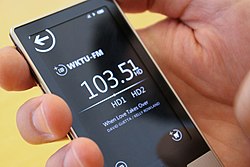
Back Zune HD Spanish Zune HD French Zune HD Italian Zune HD Dutch Zune HD Portuguese Zune HD Russian Zune HD Turkish Zune HD Ukrainian Zune HD Vietnamese
 | |
 | |
| Manufacturer | Microsoft |
|---|---|
| Type | Portable media player |
| Release date | September 15, 2009[1] |
| Discontinued | October 3, 2011 |
| Operating system | Windows CE 6.0[2] |
| CPU | Nvidia Tegra APX 2600 One ARM11 and one ARM7 general processing cores[3][4] |
| Memory | 128 MB Hynix SDRAM[5] |
| Storage | Flash memory 16, 32 and 64 GB |
| Display | 480 x 272 px (167 ppi), 3.3 in (1.62 in x 2.88 in), ≈16:9 aspect ratio, OLED display |
| Graphics | Nvidia Tegra APX 2600 Several cores dedicated to 2D and 3D graphics, audio, video, HD decoding[3] |
| Input | Multi-touch touchscreen display, accelerometer, HD Radio |
| Connectivity | Wi-Fi (802.11b/g), USB 2.0, HDMI |
| Power | 3.7 V 600 mAh Internal rechargeable non-removable lithium-ion polymer battery |
| Current firmware | 4.5 |
| Online services | Zune Marketplace |
| Dimensions | 52.7 mm (2.07 in) (w) 102.1 mm (4.02 in) (h) 8.9 mm (0.35 in) (d) |
| Weight | 74 g (2.6 oz) |
| Predecessor | Zune 80, 120 |
| Successor | Windows Phone |
The Zune HD is a portable media player in the Zune product family released on September 15, 2009, by Microsoft. It was a direct competitor with Apple's iPod Touch series of mobile devices. It was initially released in 16 and 32 GB capacities.[6] A 64 GB version was released on April 9, 2010. It has a touchscreen interface for navigation and included Wi-Fi for synchronization, access to the Zune Marketplace and Web browsing.
The Zune HD utilized the Nvidia Tegra APX 2600 chip,[7] allowing it to play 720p video through the optional HDMI Zune dock on a high-definition television. Otherwise, content would be scaled down to 480×272 pixels on the player's OLED touchscreen.[8]
- ^ Miller, Ross (2010-07-22). "Microsoft reports 1 million Zunes sold". Microsoft, via ZuneScene. Retrieved 2010-07-29.
- ^ Cite error: The named reference
cnetwas invoked but never defined (see the help page). - ^ a b Sajid, Uzair (4 April 2009). "Zune HD Powered by NVIDIA Tegra". Archived from the original on 2009-04-23. Retrieved 2009-05-27.
- ^ Cite error: The named reference
tegra_nvidiawas invoked but never defined (see the help page). - ^ Galan, Walter (2006-09-24). "Microsoft Zune HD Teardown". iFixit. Retrieved 2010-05-11.
- ^ "Preorder now available". Microsoft. 2006-08-13. Retrieved 2010-07-29.
- ^ Cross, Jason (2006-08-16). "Zune HD Specs Including Tegra Details". PCWorld.com. Archived from the original on 2011-12-13. Retrieved 2009-09-24.
- ^ Bell, Donald (2006-08-04). "Zune HD hands-on look, impressions, tears of joy". CNET. Archived from the original on 6 August 2009. Retrieved 2010-05-11.